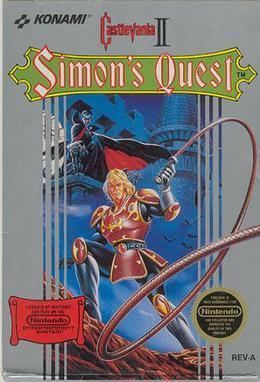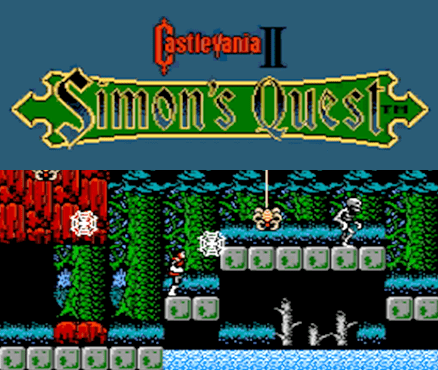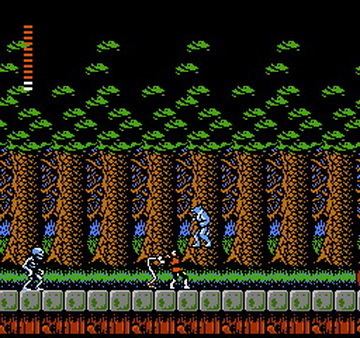8.2 /10 1 Votes8.2
Director(s) Hitoshi Akamatsu Genre(s) Platform-adventure | 4.1/5 Emuparadise Artist(s) Noriyasu Togakushi Initial release date 28 August 1987 | |||||||||||||||||||||||||||||||||
 | ||||||||||||||||||||||||||||||||||
Programmer(s) Nobuhiro MatsuokaYasuo Kuwahara Composer(s) Kenichi MatsubaraSatoe TerashimaKouji Murata Release date(s) August 28, 1987Famicom Disk SystemJP: August 28, 1987NESNA: December 1, 1988PAL: April 27, 1990WindowsNA: November 16, 2002Virtual ConsoleWiiPAL: October 19, 2007NA: October 29, 2007JP: October 28, 2008Nintendo 3DSJP: March 24, 2013INT: January 16, 2014Wii UNA: January 16, 2014JP: March 4, 2014EU: May 1, 2014 Similar Castlevania games, Konami games, Platform games | ||||||||||||||||||||||||||||||||||
Castlevania ii simon s quest video walkthrough
Castlevania II: Simon's Quest, known in Japan as Dracula II: Noroi no Fūin (ドラキュラII 呪いの封印, Dorakyura Tsū: Noroi no Fūin, "Dracula II: The Seal of the Curse"), is a platform-adventure video game produced by Konami. It was originally released for the Family Computer Disk System in Japan 1987 and for the Nintendo Entertainment System in North America in 1988. It is the second Castlevania title released for the NES, following the original Castlevania. Set sometime after the events of the first installment, the player once again assumes the role of vampire hunter Simon Belmont, who is on a journey to undo a curse placed on him by Dracula at the end of their previous encounter. With Dracula's body split into five parts after his defeat, Simon must find and bring them to the ruins of his castle to seal and defeat him.
Contents
- Castlevania ii simon s quest video walkthrough
- Castlevania ii simon s quest angry video game nerd episode 1
- Gameplay
- Development
- Audio
- Controversy
- Reception
- Legacy
- References

Castlevania ii simon s quest angry video game nerd episode 1
Gameplay

The gameplay departs from the standard platforming genre of the first Castlevania for a game more similar to the nonlinear gameplay of Metroid, with several RPG elements such as a world map which the player is free to explore and revisit. Simon, controlled by the player, can talk with townspeople who will offer him clues or lies. He can also go to merchants who will sell items, either for fighting enemies or for traversing to unreachable areas. To pay for them, he must collect hearts, which are dropped by defeated enemies. In addition to the ordinary items in Simon's inventory, he can also purchase new whips in a few locations of the game. He begins with a standard Leather Whip, and can upgrade to stronger ones with each new purchase. Simon's Quest introduces an Experience Rating system, also found in role-playing games, which is increased by collecting hearts. After he finds a sufficient amount, his level and maximum health will increase with his Experience Rating.

The period of time in Simon's Quest cycles between daytime and nightfall, which has a prominent effect on the game and Simon's encounters. During the day, the enemies outside of towns in the game are weaker. At night time, they gain strength and inflict more damage to Simon's life points, though when defeated, they drop more hearts. The townspeople and merchants in their respective locations are no longer available to talk to during night time, and are replaced by zombies.

Despite the departure from the previous game, there are elements from it that have remained. This includes the Magic Weapons, which are secondary weapons to Simon's whip. Each of them have a different use. Like most games in the series, some of these require the usage of hearts. One of them returning from Castlevania is the Holy Water, a small glass which can disintegrate walls that conceal hidden items. Some Magic Weapons make their first appearance in Simon's Quest, such as the Diamond, which attacks enemies while bouncing off any surrounding walls.
The objective of the game is to travel to the five mansions to find the body parts of Dracula's corpse, and an item known as the Magic Cross. The body parts can be utilized to support Simon in the game. For example, Dracula's Rib can be used as a shield to block any projectile attacks fired from an enemy. Finding all of the required items will allow Simon to clear the blockade in front of Dracula's castle to fight the last boss. After the player defeats Dracula, there are three possible endings based on the time taken to complete the game. The best ending is achieved when the player beats the game in eight game days.
Development
Simon's Quest was designed by Hitoshi Akamatsu, who also directed Castlevania and Castlevania III: Dracula's Curse on the NES. It was released on the FDS on August 28, 1987 in Japan.
It was eventually developed for cartridge release on the NES in North America on December 1, 1988, and in Europe on April 27, 1990. Because of hardware differences between the FDS and NES, there were changes between the versions designed for both consoles. The FDS version features a save system, as other FDS games also featured at the time. The NES version instead uses a password function to return to specific sequences from the game. The FDS medium had a data storage limitation of 862 kilobits of slow access, whereas bank-switching techniques and solid memory costs allowed cartridges to have comparable data space with much faster access. The developers used the space to improve the music quality for the game, adding percussion samples and re-arranging the melodies to take advantage of the technology. Other changes were made to correct several grammatical and spelling errors in the translation, such as rendering of the protagonist's name as "Simmon Belmont", in the game's endings. Most of the original artwork for Simon's Quest and other early Castlevania titles was lost during the Great Hanshin earthquake of 1995.
Audio
The game's soundtrack was composed by Kenichi Matsubara, who later created music for the Castlevania arcade title Haunted Castle. Of note is Bloody Tears, which has since became a recurring song in the Castlevania franchise. The album Akumajō Dracula Famicom Best was released on March 20, 1990, with the catalog number KICA-1005, and a bonus sticker. It was reprinted under Akumajō Dracula Best Vol. 1 on September 23, 1998, with the catalog number KICA-7901. It included the FDS version of Simon's Quest's music, with three bonus tracks from the NES version. The disc also includes the audio from Castlevania and Castlevania III: Dracula's Curse, covering 33 tracks altogether with a total duration of 1:04.00. Some reviewers have praised Matsubara's compositions. GameSpy stated all of the music is "incredible", and noted it for being one of the first appearances of "classics like The Silence of Daylight".
Controversy
Upon its release, Simon's Quest received strong publicity in the second issue of Nintendo Power. Its front page had a costumed model dressed as Simon Belmont, holding Dracula's severed head. This cover provoked many telephone complaints from parents of children who purchased the magazine, stating that it gave their children nightmares. Nintendo Power covered this in volume 50 of the magazine, which cited this as its worst cover.
Reception
Simon's Quest was referenced in a following issue in a Howard and Nester comic strip. Nintendo Power ranked it as the 15th best Nintendo Entertainment System video game, comparing it to Zelda II: The Adventure of Link in how it added role-playing video game elements successfully to its series.
The game garnered positive reviews following its release, and received the reputation of a Nintendo classic over time. It has an average rating of 7.5 out of 10 on the popular gaming community GameFAQs. Gaming website, IGN, cited Simon's Quest as the "perfect game to play during 1989". It praised it for its theme of exploration, and acknowledged how it evolved recent titles of the series. RPGamer noted it for being "a very rough blueprint for some amazing games to come". Numerous statements about the game also laud its graphical and audio presentation. Reviewers have complimented its visuals for being an improvement over the first Castlevania.
Simon's Quest was not without its criticism. Complaints included backtracking, easy bosses, and the day-to-night cycle. A common complaint about the game was its English localization. The clues offered by the NPCs in the game were criticized for being too cryptic and poorly translated. The producer of several Castlevania titles, Koji Igarashi, revealed in an interview that all the NPCs in the Japanese version were deliberate liars. GameSpot said that the subtle hints from the Japanese version were lost in translation. An infamous line of dialogue they gave as an example was "hit Deborah Cliff with your head to make a hole". Active Gaming Media showed that the Japanese text was similarly misleading, but went further describing where and how an accurate hint from the Japanese game was lost. Further criticism also stemmed from some of the game's puzzles, which reviewers have noted for not having any clues at all. Complaints were made towards a scenario from the game where Simon must summon a tornado in a graveyard. 1UP.com mentioned the game required a walkthrough because of its non-explanatory nature. Game Informer felt that while it was an important title in gaming history, it was still a polarizing game due to "cryptic puzzles" and other difficult elements.
Legacy
Simon's Quest was the second game in the Castlevania series to depart from linear gameplay—after Vampire Killer, published for the MSX2 home computer in 1986—and instead feature a non-linear explorative world, which has been compared to Nintendo's famous Metroid series. The game's exploration system and ideas introduced adventure elements to the series for the second time, and it would heavily influence future titles. The first game that drew inspiration from it was Castlevania: Symphony of the Night. The plot of Simon's Quest would also be directly referenced in later Castlevania games. In the Game Boy Advance entry, Castlevania: Harmony of Dissonance, the protagonist recounts when his grandfather Simon had to search for Dracula's body parts. In the game, the player must also find them again.
Simon's Quest was followed by the release of much merchandise. In 1988, Tiger Electronics released a handheld game and an LCD wristwatch based on Simon's Quest. Promotional collector's cards were also available exclusively in Japan. Worlds of Power, a series of books with stories based on Nintendo games, also had a novel about Simon's Quest. It was written by Christopher Howell, and the series was produced by Seth Godin. In 2007, a figurine of Simon's appearance from Simon's Quest was included as a pre-order bonus for Castlevania: The Dracula X Chronicles.
On November 16, 2002, Simon's Quest was a part of Castlevania and Contra: Konami Collector's Series in North America, a PC port of original Konami games. In an exclusive fan interview for the official Castlevania: Dawn of Sorrow strategy guide, Koji Igarashi considered the possibility of a compilation of the NES titles.
Simon's Quest was the target of James Rolfe's first mock review as the Angry Video Game Nerd, describing his terrible experience with the game. The joke was "how upset one obsessive gamer could get over video games that were over 20 years old."
